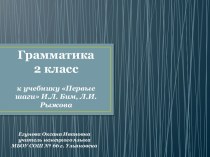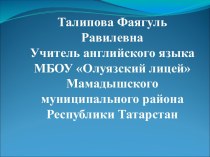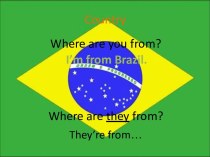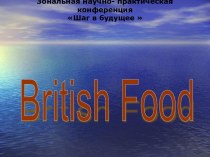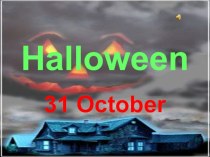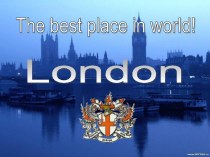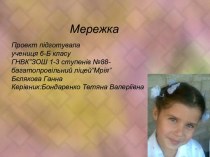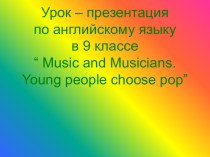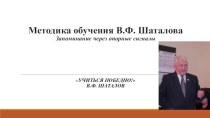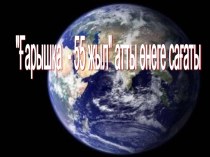- Главная
- Разное
- Бизнес и предпринимательство
- Образование
- Развлечения
- Государство
- Спорт
- Графика
- Культурология
- Еда и кулинария
- Лингвистика
- Религиоведение
- Черчение
- Физкультура
- ИЗО
- Психология
- Социология
- Английский язык
- Астрономия
- Алгебра
- Биология
- География
- Геометрия
- Детские презентации
- Информатика
- История
- Литература
- Маркетинг
- Математика
- Медицина
- Менеджмент
- Музыка
- МХК
- Немецкий язык
- ОБЖ
- Обществознание
- Окружающий мир
- Педагогика
- Русский язык
- Технология
- Физика
- Философия
- Химия
- Шаблоны, картинки для презентаций
- Экология
- Экономика
- Юриспруденция
Что такое findslide.org?
FindSlide.org - это сайт презентаций, докладов, шаблонов в формате PowerPoint.
Обратная связь
Email: Нажмите что бы посмотреть
Презентация на тему Mikhail Lomonosov
Содержание
- 2. Mikhail
- 3. Mikhail Vasilievich Lomonosov (1711-1765) will forever remain
- 4. Aspiring to get
- 5. (М.Ломоносов слайд 2) The son of a
- 6. He became the first Russian professor of chemistry at St. Petersburg Academy of Science in 1745.
- 7. His major scientificaccomplishment was in the field
- 8. Mikhail Lomonosov was the one who created
- 9. Interested in furthering Russian education, Lomonosov wrote
- 10. He published the first history of Russia
- 11. He also revived the art of Russian
- 12. Famous Russian poet Alexander Pushkin wrote about
- 13. Использованные источники:http://d1.dvinainform.ru/data/files/12/0f/00000f12.jpg (М.Ломоносов слайд 3) http://www.mpda.ru/data/2011/11/25/1234994183/396x533_1_0_images_11_november2010_LOMONOSOV.jpg (М.Ломоносов
- 14. http://s59.radikal.ru/i164/1101/b6/8ed7158e702e.jpg (Михаилъ Ломоносовъ - Древняя россiйская исторiя,
- 15. Скачать презентацию
- 16. Похожие презентации
Mikhail LomonosovRussia's first world-famed specialist in natural science, a poet who laid down the foundations of Russian literary language and an advocate of education.
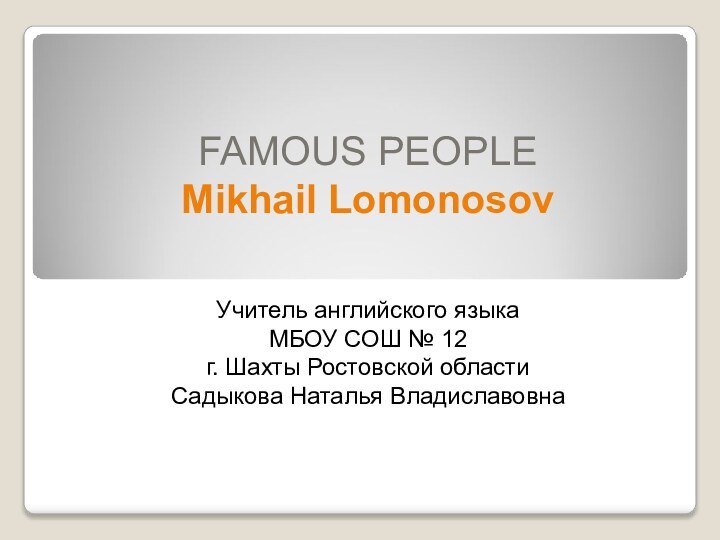
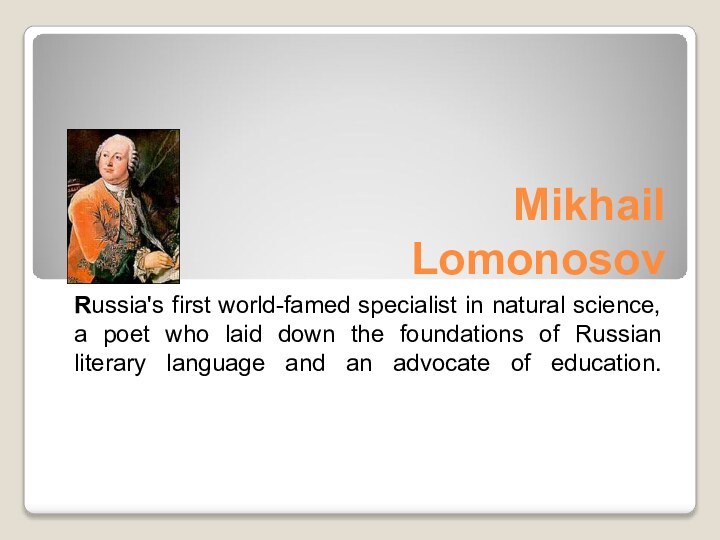

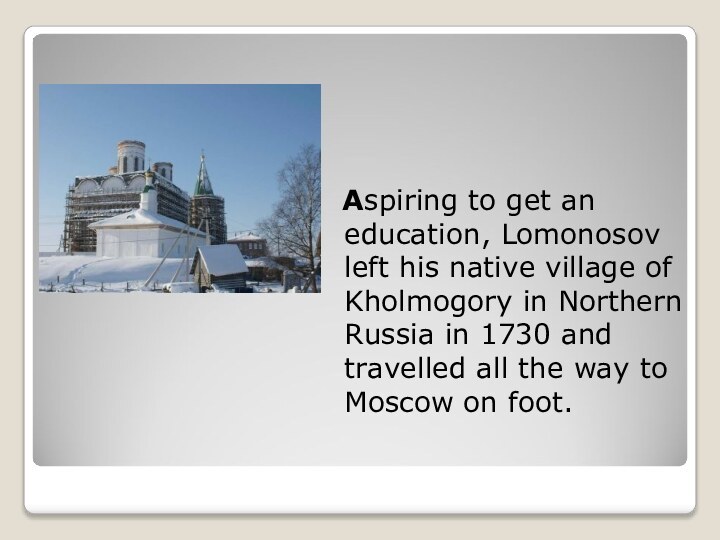

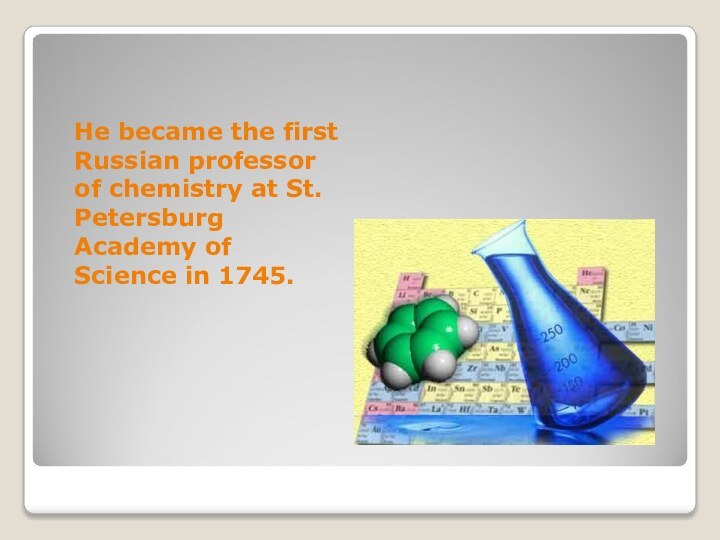

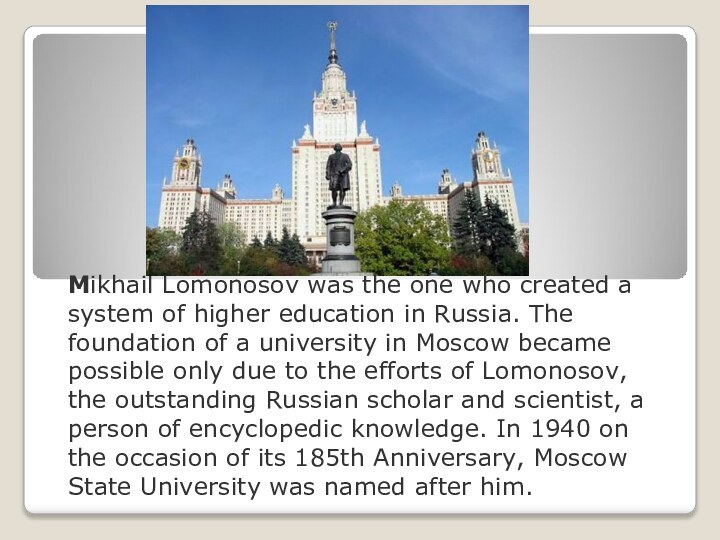
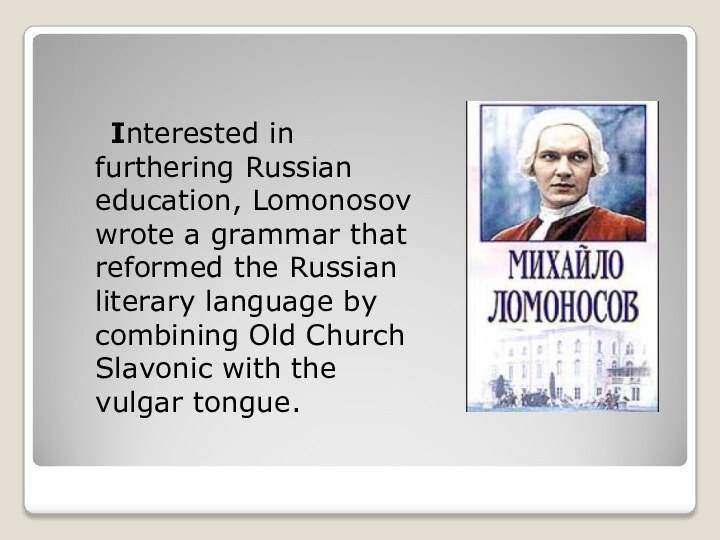
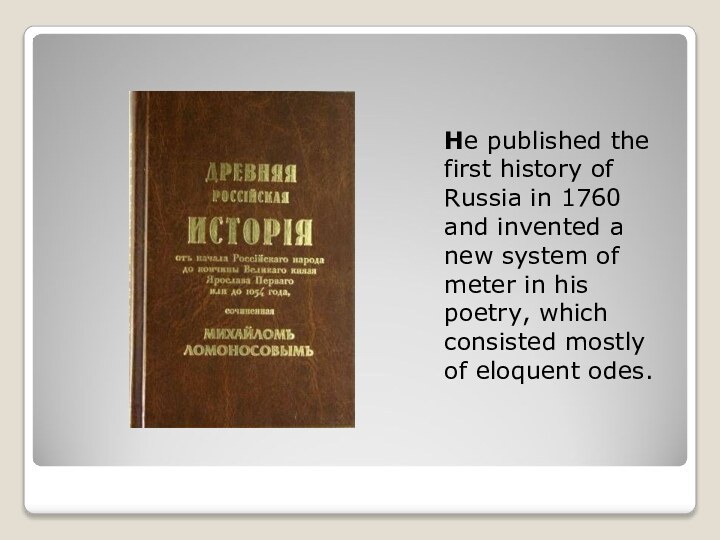
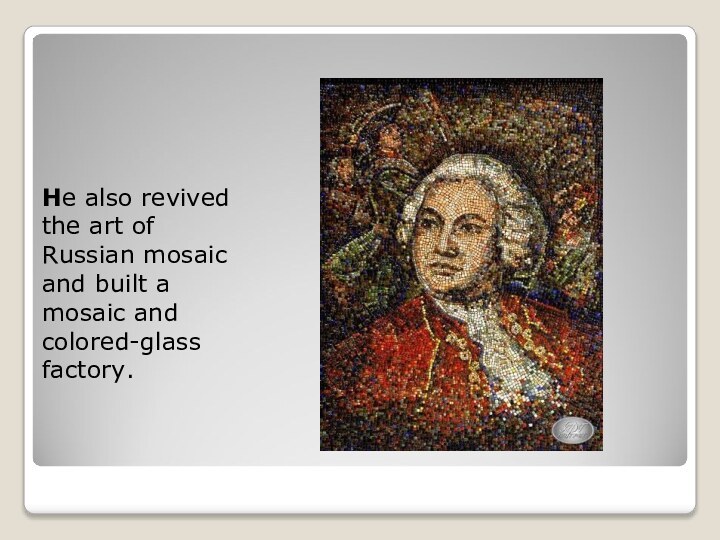
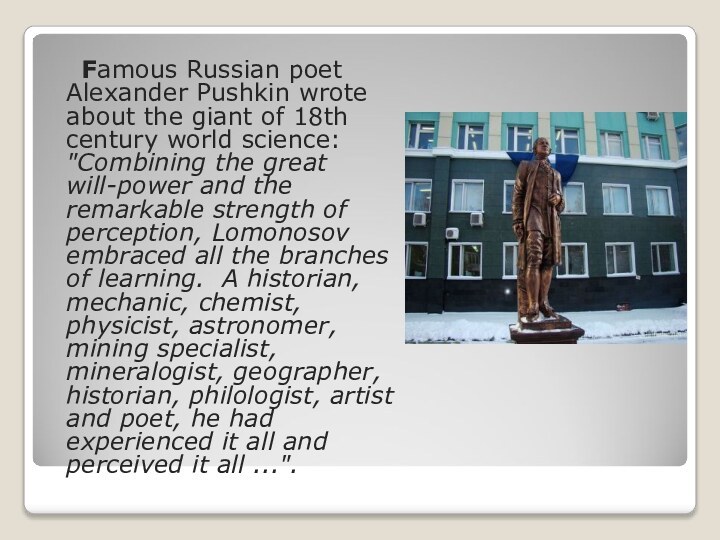
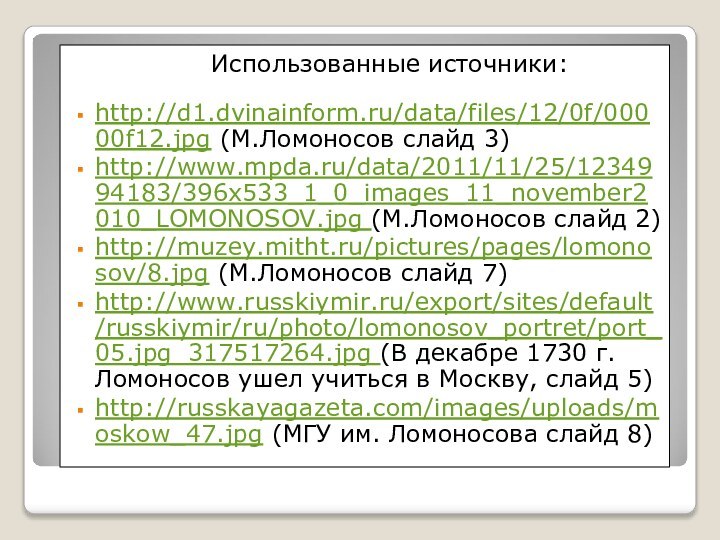
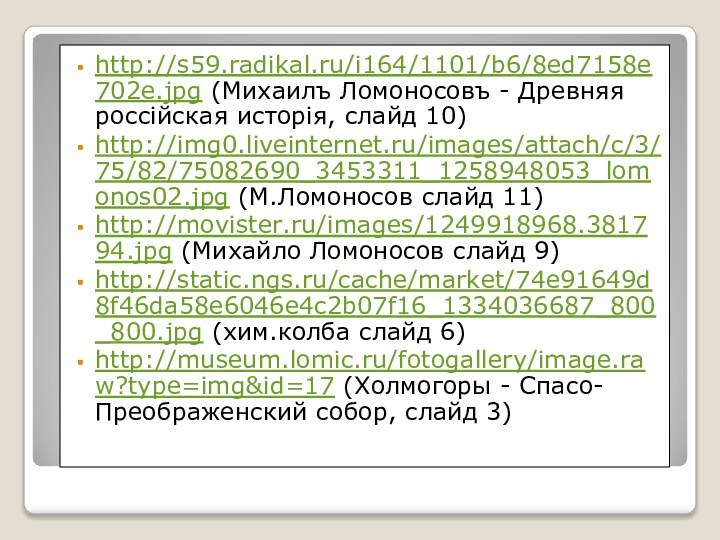
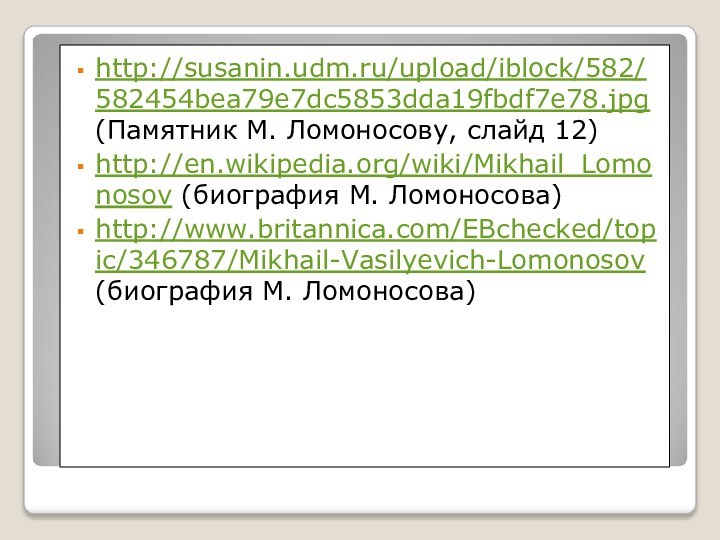
Слайд 2 Mikhail
Lomonosov
who laid down the foundations of Russian literary language and an advocate of education.
Слайд 3
Mikhail Vasilievich Lomonosov (1711-1765) will forever remain in
the history of Russian science as
"the first and
the greatest."
Слайд 4
Aspiring to get an
education, Lomonosov left his native village of Kholmogory in
Northern Russia in 1730 and travelled all the way to Moscow on foot.
Слайд 5
(М.Ломоносов слайд 2)
The son of a poor
fisherman, he had to conceal his origin in order
to be admitted to the Slavonic-Greek-Latin Academy of Moscow, where he started his education at the age of 19. Recognized by his instructors as an excellent student, he completed his education in St. Petersburg and in Germany.Слайд 6 He became the first Russian professor of chemistry
at St. Petersburg Academy of Science in 1745.
Слайд 7
His major scientific
accomplishment was in
the field of
physical chemistry, with other notable discoveries in astronomy, geophysics,
geology, metallurgy and mineralogy.Слайд 8 Mikhail Lomonosov was the one who created a
system of higher education in Russia. The foundation of
a university in Moscow became possible only due to the efforts of Lomonosov, the outstanding Russian scholar and scientist, a person of encyclopedic knowledge. In 1940 on the occasion of its 185th Anniversary, Moscow State University was named after him.
Слайд 9
Interested in furthering Russian education, Lomonosov wrote a
grammar that reformed the Russian literary language by combining
Old Church Slavonic with the vulgar tongue.
Слайд 10
He published the first history of Russia in
1760 and invented a new system of meter in
his poetry, which consisted mostly of eloquent odes.
Слайд 12
Famous Russian poet Alexander Pushkin wrote about the
giant of 18th century world science: "Combining the great
will-power and the remarkable strength of perception, Lomonosov embraced all the branches of learning. A historian, mechanic, chemist, physicist, astronomer, mining specialist, mineralogist, geographer, historian, philologist, artist and poet, he had experienced it all and perceived it all ...".
Слайд 13
Использованные источники:
http://d1.dvinainform.ru/data/files/12/0f/00000f12.jpg (М.Ломоносов слайд 3)
http://www.mpda.ru/data/2011/11/25/1234994183/396x533_1_0_images_11_november2010_LOMONOSOV.jpg (М.Ломоносов слайд
2)
http://muzey.mitht.ru/pictures/pages/lomonosov/8.jpg (М.Ломоносов слайд 7)
http://www.russkiymir.ru/export/sites/default/russkiymir/ru/photo/lomonosov_portret/port_05.jpg_317517264.jpg (В декабре 1730 г.
Ломоносов ушел учиться в Москву, слайд 5)http://russkayagazeta.com/images/uploads/moskow_47.jpg (МГУ им. Ломоносова слайд 8)
Слайд 14 http://s59.radikal.ru/i164/1101/b6/8ed7158e702e.jpg (Михаилъ Ломоносовъ - Древняя россiйская исторiя, слайд
10)
http://img0.liveinternet.ru/images/attach/c/3/75/82/75082690_3453311_1258948053_lomonos02.jpg (М.Ломоносов слайд 11)
http://movister.ru/images/1249918968.381794.jpg (Михайло Ломоносов слайд
9) http://static.ngs.ru/cache/market/74e91649d8f46da58e6046e4c2b07f16_1334036687_800_800.jpg (хим.колба слайд 6)
http://museum.lomic.ru/fotogallery/image.raw?type=img&id=17 (Холмогоры - Спасо-Преображенский собор, слайд 3)
